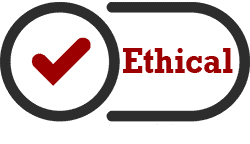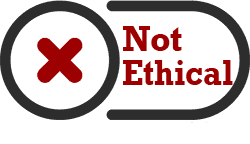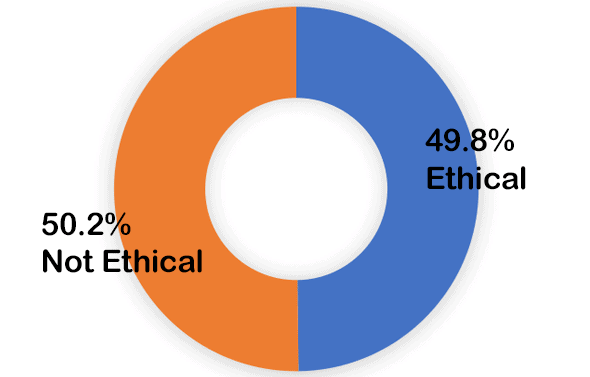This is the September 2020 edition of our monthly series of Ethics case studies titled What Do You Think? This series is comprised of case studies from NSPE archives, involving both real and hypothetical matters submitted by engineers, public officials and members of the public.
Your peers and the NSPE Board of Ethical Review have reviewed the facts of the case as shown below. And, here are the results.
Your opinion has been registered for the September 2020 edition of our monthly series of Ethics case studies titled What Do You Think?
Your vote is recorded as:

Want to know how your peers voted? We’ll send you an email with the poll results on September 22.
Your opinion has been registered for the September 2020 edition of our monthly series of Ethics case studies titled What Do You Think?
Your vote is recorded as:

Want to know how your peers voted? We’ll send you an email with the poll results on September 22.
A Review of the Facts
Engineer Craig is employed by UVW Consultants, a major structural engineering firm, and is acting project manager for the construction of a bridge. After completing his work on the bridge, Craig leaves the firm and associates with another structural engineering firm, which has no relationship with the bridge project. As an employee of the new firm, Craig authors an article for an international structural engineering journal on the bridge project. Under the title of the article, Craig lists his name and identifies his affiliation with his current firm. The only credit given to UVW Consultants is listed at the end of the article under “Engineer of Record.”
Was it ethical for Craig to list his name and the two firm names in the manner indicated?
Here is the result of our survey of your peers:

Applicable NSPE Code References:
Code II.3: Engineers shall issue public statements only in an objective and truthful manner.
Code II.3.a: Engineers shall be objective and truthful in professional reports, statements, or testimony. They shall include all relevant and pertinent information in such reports, statements, or testimony, which should bear the date indicating when it was current.
Code II.5.a: Engineers shall not falsify their qualifications or permit misrepresentation of their or their associates’ qualifications. They shall not misrepresent or exaggerate their responsibility in or for the subject matter of prior assignments. Brochures or other presentations incident to the solicitation of employment shall not misrepresent pertinent facts concerning employers, employees, associates, joint venturers, or past accomplishments.
Code III.1: Engineers shall be guided in all their relations by the highest standards of honesty and integrity.
Code III.3.a: Engineers shall avoid the use of statements containing a material misrepresentation of fact or omitting a material fact.
Code III.9: Engineers shall give credit for engineering work to those to whom credit is due, and will recognize the proprietary interests of others.
Discussion
Similar cases were considered by the BER in 92-5 and 85-2.
The obligation of the engineer to give appropriate credit for other’s work was considered in Case 92-7 (which also dealt with responsibility to identify the source of data). In that case, Engineer B, a professor of civil engineering, conducted research and developed a paper based on data obtained from professors in the chemistry department, who did not reveal that the data was generated by Engineer A and XYZ Consultants. Engineer B then published a paper using this data.
Engineer A’s data was displayed prominently therein and the work of XYZ constituted a major part of the paper, with no credit being given to either. After publication, Engineer B learned the actual source of the data and finding. The question: Did Engineer B have an ethical obligation to clarify the source of data contained in the paper? In evaluating the case that the Board considered earlier in Case 75-11, it was made clear that the engineer must clearly and individually identify each source of data.
Another case, 92-1, also addressed whether it was ethical for an engineer to fail to give credit for another engineer’s work. There, Engineer C, the prime professional contractor for the design of an elevated highway bridge, employed Engineer D, for his special expertise, to design a critical aspect of the bridge. Engineer C later entered the bridge in a national contest, winning the prize.
However, the entry failed to credit Engineer D for his part of the design. Following discussion of the relevant Code sections, the Board decided that it was unethical for Engineer C to fail to give credit to Engineer D.
This case differs from these earlier cases in that, while giving prominence to his new firm by its identification at the title, Craig did list UVW Consultants as “Engineer of Record” at the end of the article. While it may be argued that the stated listings were not dishonest, the Board cannot accept that defense for something so potentially misleading and unfair. Consider—had the author been a journalist or freelance technical writer, surely UVW Consultants, the design firm, would have been recognized as material to the article and would have been clearly identified within the body of the article. Craig’s failure to include that relevant and material information is believed to be deliberate and less than forthright.
Other sections of the Code are also considered relevant in the instant case. In its third sentence, the Preamble requires “…honesty, fairness and equity…” And Code III.1 states that “Engineers shall be guided…by the highest standards of honesty and integrity.” We do not hold that Craig behaved according to these standards toward his former employer, UVW, in his article.
Also relevant is Code II.3 which requires that engineers shall issue public statements only in an objective and truthful manner. Code II.3.a. goes further by saying that “…They shall include all relevant and pertinent information…” Neither his opening identification, nor his closing listing of the engineer of record can serve as full compliance here.
Code II.5.a. provides that engineers shall not falsify or permit misrepresentation of…their associates’ qualifications. We believe that the opening identification with his present employer serves to impute the qualification in the article to the new employer who had nothing to do with the project.
And Code III.3.a. provides that “Engineers shall avoid the use of statements containing a material misrepresentation of fact or omitting a material fact.” Once again, Craig’s article fails to pass muster.
Finally, Craig’s article is deficient when measured by Code III.9 which requires that engineers shall give credit for engineering work to those to whom credit is due, and will recognize the proprietary interests of others.
The Ethical Review Board’s Conclusion

It was unethical for Craig to list his name and the two firm names in the manner indicated.
BOARD OF ETHICAL REVIEW
William A. Cox, Jr., P.E., James G. Fuller, P.E., Donald L. Hiatte, P.E., Robert L. Nichols, P.E., William E. Norris, P.E., Jimmy H. Smith, Ph.D., P.E., William W. Middleton, P.E., Chairman
Note: The Board of Ethical Review operates on an “ad hoc” educational basis, and does not engage in resolving disputes of fact between parties in actual cases. That function is left to the state society if members are involved in judging whether a member has violated the Code of Ethics. Being solely educational, the function of the Board is to take the submission of “facts” as the basis for analysis and opinion without attempting to obtain rebuttal or comment from other parties. On that basis, the reader of the opinions should always recognize that the Board of Ethical Review is not an adjudicatory body, and unless indicated otherwise, its opinions are not binding upon the National Society of Professional Engineers, any state engineering society or any individual. Instead, the opinions represent the opinions of licensed engineers as to the reasonable standards of practice within the engineering profession. Board of Ethical Review opinions are intended to provide guidance in actual cases only to the extent of the “facts”, stated in the case. Cases may be reproduced for educational purposes as long as the material reproduced provides appropriate attribution to NSPE and the Board of Ethical Review.








It ok.
It’s a borderline case.
Unfortunately, the case occurs way too often. It seems to be very common within an organization for the same type of situation to occur. Too often an aggressive engineer sees the opportunity to infer credit for an other engineers accomplishment. Conversely, too often discredit to another engineer can be inferred by the aggressive engineer that actually made poor decisions in his own project, concept and design.
I don’t believe it is borderline. I believe the engineer knew exactly what he was doing in trying to gain favor with his new company. That happens often too. The engineer has an obligation to be fair, forthright and honest. That is our profession. He certainly can state he managed the work under the previous organization. That actually works to his advantage, as he gives credit where due; no burned bridges and brings a level of experience to his new company.
I believe that the results of your survey establish as fact that the majority of project design level engineers want nothing to do with the responsibility to continue in their position.
The survey has the potential to inspire a schism between those engineers who work on projects and those engineers who manage projects and budgets. The former believe their view to be righteous and thus the survey serves to diminish their respect for the latter.
Your survey fails to acknowledge the legal responsibilities that PEs assume as engineer of record. I voted yes because I am individually responsible for what I sign as the engineer of record. I take that responsibility with me everywhere I go.